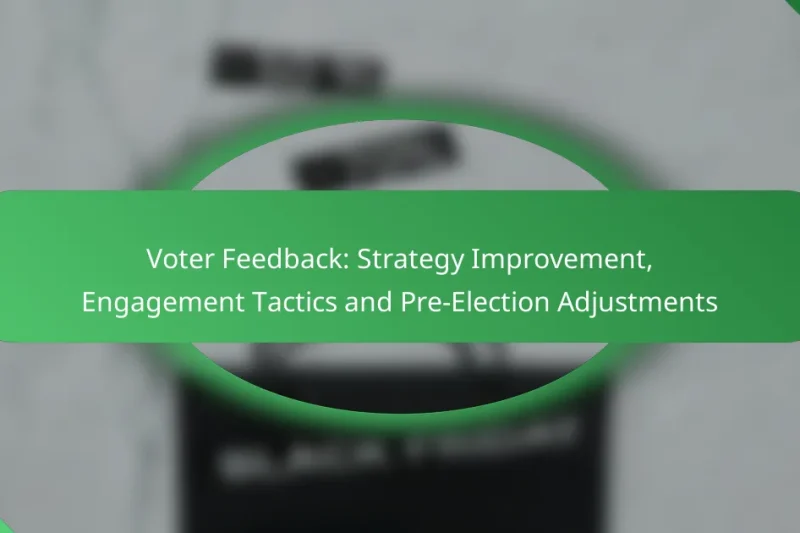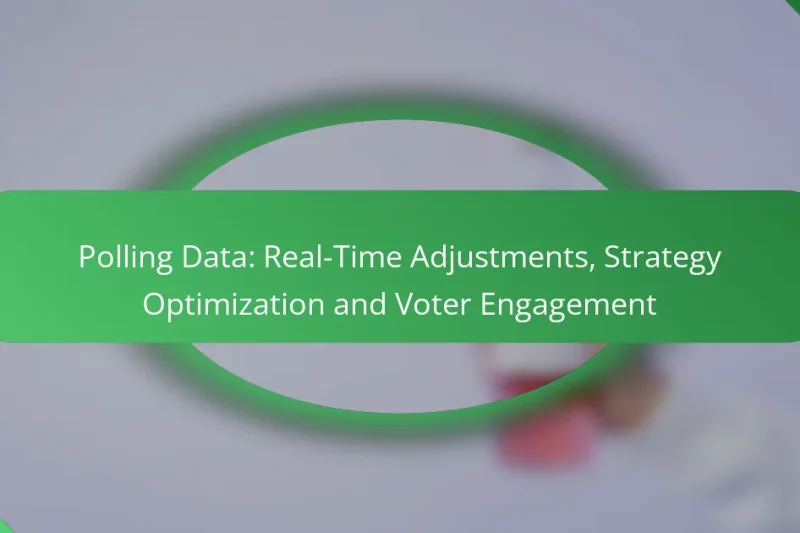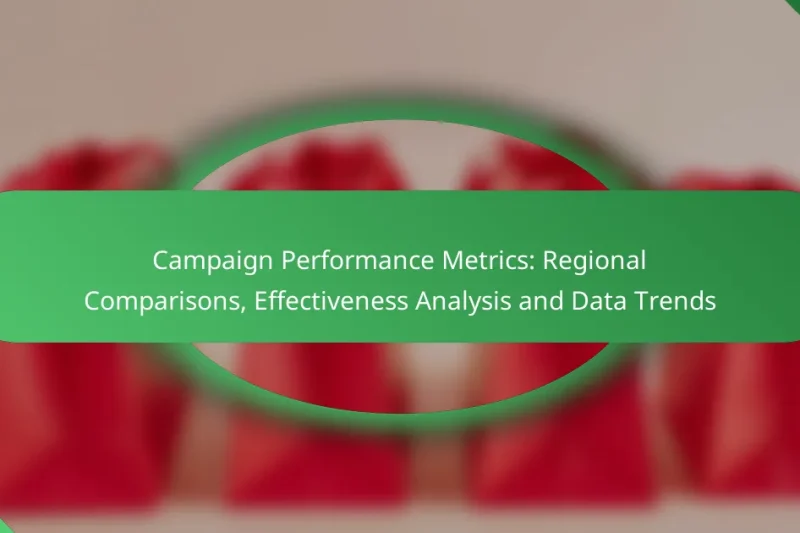Campaign ads can greatly benefit from A/B testing, a method that compares two ad versions to … Campaign Ads: A/B Testing, Effectiveness Evaluation and Audience InsightsRead more
Campaign Analytics for Effective Strategies
Campaign analytics plays a vital role in shaping effective marketing strategies by offering valuable insights into performance and audience behavior. By utilizing tools like Google Analytics and HubSpot Marketing Hub, marketers can track key metrics that inform decision-making and optimize resource allocation. This data-driven approach leads to improved outcomes and a deeper understanding of campaign effectiveness.
Campaign Performance Metrics: Key Indicators, Swing State Analysis and Data Tracking
Campaign performance metrics are crucial for assessing the effectiveness of political strategies and identifying areas for … Campaign Performance Metrics: Key Indicators, Swing State Analysis and Data TrackingRead more
Voter Feedback: Strategy Improvement, Engagement Tactics and Pre-Election Adjustments
Voter feedback plays a crucial role in shaping effective campaign strategies by offering valuable insights into … Voter Feedback: Strategy Improvement, Engagement Tactics and Pre-Election AdjustmentsRead more
Polling Data: Real-Time Adjustments, Strategy Optimization and Voter Engagement
Polling data plays a crucial role in enhancing voter engagement by offering valuable insights into voter … Polling Data: Real-Time Adjustments, Strategy Optimization and Voter EngagementRead more
Campaign Data Tools: Analysis Platforms, Consultant Resources and Performance Insights
Campaign data tools are essential for marketers seeking to optimize their strategies through insightful analysis. These … Campaign Data Tools: Analysis Platforms, Consultant Resources and Performance InsightsRead more
Campaign Analytics Dashboard: Real-Time Insights, Performance Tracking and Data Visualization
The Campaign Analytics Dashboard is an essential tool for marketers, offering real-time insights and performance tracking … Campaign Analytics Dashboard: Real-Time Insights, Performance Tracking and Data VisualizationRead more
Campaign Performance Metrics: Regional Comparisons, Effectiveness Analysis and Data Trends
Campaign performance metrics vary across regions due to differences in consumer behavior, market conditions, and cultural … Campaign Performance Metrics: Regional Comparisons, Effectiveness Analysis and Data TrendsRead more
What are the best campaign analytics tools for marketers in the US?
The best campaign analytics tools for marketers in the US include Google Analytics, HubSpot Marketing Hub, Adobe Analytics, Mixpanel, and Tableau. These platforms provide essential insights into campaign performance, audience behavior, and overall marketing effectiveness.
Google Analytics
Google Analytics is a widely-used tool that tracks website traffic and user behavior. It offers features like real-time data, audience segmentation, and conversion tracking, making it essential for understanding how campaigns drive traffic and engagement.
Marketers can set up goals to measure specific actions, such as form submissions or purchases, allowing them to assess the effectiveness of their campaigns. The free version is suitable for small to medium businesses, while Google Analytics 360 offers advanced features for larger enterprises.
HubSpot Marketing Hub
HubSpot Marketing Hub combines analytics with a comprehensive suite of marketing tools, including email marketing, social media management, and content creation. Its analytics dashboard provides insights into campaign performance across various channels.
One key advantage is its ability to track leads through the sales funnel, helping marketers understand which campaigns convert best. HubSpot offers a free tier, but advanced features require a subscription, which can range from hundreds to thousands of dollars per month depending on the plan.
Adobe Analytics
Adobe Analytics is a powerful tool designed for enterprises needing in-depth analysis of customer data. It provides advanced segmentation, predictive analytics, and real-time reporting, allowing marketers to make data-driven decisions.
This tool is particularly useful for businesses with complex data needs, as it integrates seamlessly with other Adobe products. However, it can be costly, making it more suitable for larger organizations with substantial budgets for analytics.
Mixpanel
Mixpanel focuses on product and user analytics, offering insights into user interactions and engagement. It allows marketers to track specific events and actions, making it ideal for understanding user behavior in detail.
Mixpanel’s funnel analysis helps identify where users drop off in the conversion process, enabling targeted improvements. Pricing is based on the number of data points tracked, which can be beneficial for startups but may become expensive as usage grows.
Tableau
Tableau is a data visualization tool that helps marketers analyze and present campaign data effectively. It allows users to create interactive dashboards and reports, making complex data easily understandable.
While Tableau does not specialize in campaign analytics alone, its ability to integrate with various data sources makes it a valuable asset for marketers looking to visualize their performance metrics. Pricing can vary widely, with options for individual users and larger teams.
How can campaign analytics improve marketing strategies?
Campaign analytics can significantly enhance marketing strategies by providing insights into performance, audience behavior, and overall effectiveness. By leveraging data, marketers can make informed decisions that lead to improved outcomes and more efficient resource allocation.
Data-driven decision making
Data-driven decision making involves using analytics to guide marketing choices rather than relying on intuition. This approach allows marketers to identify trends, optimize campaigns, and allocate budgets effectively. For instance, analyzing past campaign data can reveal which channels yield the highest return on investment (ROI).
To implement data-driven strategies, marketers should establish key performance indicators (KPIs) that align with their goals. Regularly reviewing these metrics helps in adjusting tactics in real-time, ensuring that campaigns remain relevant and effective.
Enhanced audience targeting
Enhanced audience targeting is achieved by analyzing demographic and behavioral data to identify specific customer segments. This allows marketers to tailor messages and offers to meet the unique needs of different groups, increasing engagement and conversion rates. For example, a campaign targeting young adults may focus on social media platforms, while one aimed at older consumers might utilize email marketing.
Utilizing tools like customer relationship management (CRM) systems can help gather and analyze audience data. Marketers should continuously refine their targeting strategies based on campaign performance and audience feedback to ensure optimal results.
Performance measurement
Performance measurement is crucial for understanding the effectiveness of marketing campaigns. By tracking metrics such as conversion rates, click-through rates, and customer acquisition costs, marketers can assess what works and what doesn’t. This data is essential for making adjustments and improving future campaigns.
To effectively measure performance, marketers should use a combination of quantitative and qualitative data. Employing A/B testing can provide insights into which variations of a campaign resonate better with the audience. Regularly reviewing performance metrics ensures that strategies remain aligned with business objectives and market trends.
What metrics should be tracked in campaign analytics?
Tracking the right metrics in campaign analytics is crucial for evaluating performance and optimizing strategies. Key metrics include conversion rate, click-through rate, return on investment, and customer acquisition cost, each providing insights into different aspects of campaign effectiveness.
Conversion rate
The conversion rate measures the percentage of users who complete a desired action, such as making a purchase or signing up for a newsletter. A higher conversion rate indicates that your campaign effectively persuades users to take action. Aim for a conversion rate between 2-5% for most online campaigns, but this can vary significantly by industry.
To improve your conversion rate, focus on optimizing landing pages, ensuring clear calls to action, and targeting the right audience. Regularly A/B test different elements to identify what resonates best with your audience.
Click-through rate
Click-through rate (CTR) indicates the percentage of users who click on a specific link compared to the total number of users who view an ad or email. A good CTR typically falls between 1-3%, depending on the platform and industry. Monitoring CTR helps gauge the effectiveness of your messaging and creative assets.
To enhance your CTR, use compelling headlines, engaging visuals, and clear calls to action. Experiment with different ad placements and formats to see which combinations yield the best results.
Return on investment
Return on investment (ROI) measures the profitability of your campaign by comparing the revenue generated to the costs incurred. A positive ROI indicates that your campaign is financially successful. Aim for an ROI of at least 100% to ensure that your campaigns are worth the investment.
To calculate ROI, use the formula: (Net Profit / Cost of Investment) x 100. Regularly review your ROI to identify underperforming campaigns and allocate resources more effectively.
Customer acquisition cost
Customer acquisition cost (CAC) is the total cost of acquiring a new customer, including marketing expenses, sales costs, and any other related expenditures. Understanding CAC helps you evaluate the efficiency of your marketing strategies. A CAC that is significantly lower than the lifetime value of a customer is ideal.
To calculate CAC, divide total acquisition costs by the number of new customers acquired during a specific period. Keep track of CAC over time to identify trends and adjust your marketing budget accordingly. Aim to keep CAC as low as possible while still achieving quality leads.
What are the prerequisites for effective campaign analytics?
Effective campaign analytics require clear objectives, a well-defined target audience, and appropriate data collection tools. These elements ensure that the analysis is focused, relevant, and actionable.
Clear campaign objectives
Establishing clear campaign objectives is crucial for effective analytics. Objectives should be specific, measurable, achievable, relevant, and time-bound (SMART). For example, instead of aiming to “increase sales,” a clearer objective would be to “boost online sales by 20% over the next quarter.”
These objectives guide the analytics process, helping to determine which metrics to track and analyze. Without defined goals, it becomes challenging to assess the effectiveness of a campaign or make informed adjustments.
Defined target audience
Identifying a defined target audience is essential for tailoring campaigns and ensuring relevant data collection. Understanding demographics, interests, and behaviors helps in crafting messages that resonate with potential customers. For instance, a campaign aimed at millennials may use different channels and messaging than one targeting retirees.
Utilizing buyer personas can aid in visualizing the target audience. This approach allows marketers to create more personalized experiences, leading to higher engagement and conversion rates.
Data collection tools
Choosing the right data collection tools is vital for gathering accurate and actionable insights. Tools like Google Analytics, social media insights, and customer relationship management (CRM) systems can provide valuable data on user behavior and campaign performance. Selecting tools that integrate well with existing systems can streamline the analytics process.
It’s important to ensure that data collection methods comply with relevant regulations, such as GDPR in Europe or CCPA in California. Regularly reviewing and updating data collection strategies can help maintain data quality and relevance over time.



